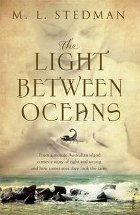The light between oceans by M. L Stedman

Vintage Books, 2012. ISBN 9781742755700.
Tom Sherbourne is a young, decorated soldier just returned from the
horrors of the Western Front of World War 1, horrified by the things
he has seen and done, and guilty because he has survived relatively
whole when so many have not. He seeks refuge by becoming a
lighthouse keeper on some of Australia's most remote lighthouses,
which, in those days were not automated as they are now. In a tiny
town in remote south-western Australia, he meets and marries the
love of his life and they live a cocooned life on a tiny island 100
miles offshore, their days only interrupted by the
once-every-three-months visit of the supply boat. Until one day, a
boat washes ashore carrying a dead man and a crying infant and a
choice is made that changes and shapes their lives forever.
Although I don't usually review adult books, this is the most
intriguing read I've had for a long time and I think it has a place
on the shelves of secondary libraries for a lot of reasons. Apart
from the insight it gives us into the mindset of young soldiers who
went to war full of high hopes and adventure but, in reality saw and
did what no person should see and do and were then eventually
returned Australia and just expected 'to get on with it', it is a
story of moral and ethical dilemmas which would provide engaging
discussion and debate that would have every student having to
examine their core values and beliefs. As the cover quote says,
'This is a story of right and wrong, and sometimes they look the
same.' Every character has a solid place in this story and the
question of 'What would you have done if you were them?' could be
put for each one. And because of the quality of the writing,
students will learn that there are seldom black-and-white answers to
these sorts of big questions - there are many shades of grey to be
considered and every action has a reaction, intended or not.
Beyond that, there are discussion
questions available (and there are advertisements and links on
that page that could become a teachable moment about cyber-safety)
that could also form the basis of some broader in-depth discussions
such as 'Are right and wrong absolutes, or do they change depending
on your point of view? If they are not fixed points, how do you
decide what's right and what's wrong, and what happens when your
values differ from your neighbour's?' and 'The continent of
Australia hasn't moved since 1926, but are we, as a nation closer to
the centre of things - more 'stitched into the world's fabric'?
Discuss isolation then and now, and its effect on the nation's
psyche.' I would also add, 'Although on the surface, Tom and
Isobel's isolation was physical, it is possible to be isolated while
surrounded by people?' which might lead to discussion and
acknowledgement of mental health issues, not only as they relate to
Tom and Isobel in the mainland but also to the students themselves.
For me, this book is a keeper - which is the highest praise I can
offer.
Barbara Braxton